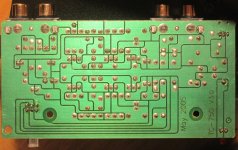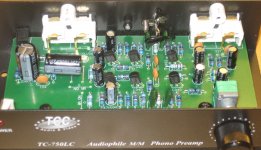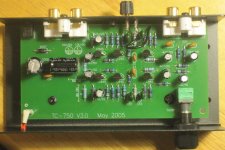Hi,
I have a TCC TC-750LC phono preamp. I want to increase it's gain by about 6db -10db. It seems that I should be able to tweak the values of a couple of components to do that. But I would be mostly guessing what to change since I only partially understand the circuit. Anybody have some good thoughts on how to accomplish this without hurting it's other performance levels?
Thanks,
Specs. for the TC-750LC:
12 volt DC,
Output level control with >85dB range,
RIAA freq response 20hz-20,000hz +/- 0.5dB,
S/N ratio >85dB,
THD <0.05%, input sensitivity 3.0mV,
Gain 40dB,
Nominal / max output 300mV / 1.8V,
Output impedance 1k ohm,
Input 47k ohm /220 pF
Here is a link to a schematic. and a couple of pictures of the PCB I took:
http://beavishifi.com/articles/phono-preamps/TCC-TC750-Phono-Preamp-Schematic-1200.png
I have a TCC TC-750LC phono preamp. I want to increase it's gain by about 6db -10db. It seems that I should be able to tweak the values of a couple of components to do that. But I would be mostly guessing what to change since I only partially understand the circuit. Anybody have some good thoughts on how to accomplish this without hurting it's other performance levels?
Thanks,
Specs. for the TC-750LC:
12 volt DC,
Output level control with >85dB range,
RIAA freq response 20hz-20,000hz +/- 0.5dB,
S/N ratio >85dB,
THD <0.05%, input sensitivity 3.0mV,
Gain 40dB,
Nominal / max output 300mV / 1.8V,
Output impedance 1k ohm,
Input 47k ohm /220 pF
Here is a link to a schematic. and a couple of pictures of the PCB I took:
http://beavishifi.com/articles/phono-preamps/TCC-TC750-Phono-Preamp-Schematic-1200.png
Attachments
Hi,
Just took a quick glance.
A short remark at first: increasing gain always cost a noise-, distortion- and bandwidth-penalty.
The gain is defined by the impedance of the EQ-network (R5,6,15,C4,5) over R4s value ( at dc) resp. R3s value at ac. If R3 is reduced to say 100 ohms the gain should rise by a factor of 3.3 or ~+10dB. 165 ohms for R3 should double the gain, giving +6dB. C3 forms a subsonic filter thats centre frequency shifts linearly with R3s value. Reducing R3s value by a factor X requires an increase in C3s value by the same factor.
You can start with decreasing R3, leaving C3 as it is. If you audition a slight loss in Bass amplitude increase C3, otherwise You may leave it as is.
You can decrease R3s value eithe by direct replacement or by paralleling a srcond resistor to R3. A second 330Ohm would result in 165Ohms and +6dB gain. A 140Ohms resistor would result in 100Ohms, +10dB.
C3s value increses with paralleled caps. The values simply sum up.
So tweaking should be easy, as would be reinstalling original state.
Jauu
Calvin
Ps. Just wondering what all may be called an audiophile amplifier nowadays ;-)
Just took a quick glance.
A short remark at first: increasing gain always cost a noise-, distortion- and bandwidth-penalty.
The gain is defined by the impedance of the EQ-network (R5,6,15,C4,5) over R4s value ( at dc) resp. R3s value at ac. If R3 is reduced to say 100 ohms the gain should rise by a factor of 3.3 or ~+10dB. 165 ohms for R3 should double the gain, giving +6dB. C3 forms a subsonic filter thats centre frequency shifts linearly with R3s value. Reducing R3s value by a factor X requires an increase in C3s value by the same factor.
You can start with decreasing R3, leaving C3 as it is. If you audition a slight loss in Bass amplitude increase C3, otherwise You may leave it as is.
You can decrease R3s value eithe by direct replacement or by paralleling a srcond resistor to R3. A second 330Ohm would result in 165Ohms and +6dB gain. A 140Ohms resistor would result in 100Ohms, +10dB.
C3s value increses with paralleled caps. The values simply sum up.
So tweaking should be easy, as would be reinstalling original state.
Jauu
Calvin
Ps. Just wondering what all may be called an audiophile amplifier nowadays ;-)
Maybe you should add a little line driver stage that supplies the 6db gain, and thus leave the current preamp unchanged. It could be done with a LME49990 (or something like that).
Calvin,
Thanks for your analysis and suggestions. Without it I would have assumed that lowering the value of R4 would have been the place to start. My soldering skills are much better than my transistor theory and circuit understanding, so I will try piggybacking a few different resistors onto R3 and see what I get for output. Do you have any guesstimate on what degree of noise/distortion/etc. increase I might see? Is that typically a linear relationship to gain?
Yes the term "Audiophile" does seem to miss the mark here. But for $50 the TC-750LC seemed to be the best thing at it's price point. And at the time I did not realize I would need more gain than it could provide. It might be an interesting discussion about whether the TC-750LC could be upgraded with some better quality components or minor modifications to get lower noise/distortion/etc.
FdW
Thanks for your reply. Adding a line-level amp was/is my other option. Are you suggesting a wholly separate amp, or the addition of driver stage within the shell of the TC-750LC? I have only thought of adding an external amp up till now. There are several kits on ebay I have been looking at, and any number of schematics & part-lists on forums all suggesting how good they are. But it is always hard for me to evaluate if they will be right for my situation. I have not seen any designs that are advertised as for giving the 6db to 10db with a 150-300mv input and up to about 1.5v or so output.
One of the things I'm trying to do is drive a M-Audio 24/96 soundcard to make some transfers to digital. It is specd at 10kohm (min) analog input impedance, and 2v max input, but it clips at about 1.5v.
Thanks for your analysis and suggestions. Without it I would have assumed that lowering the value of R4 would have been the place to start. My soldering skills are much better than my transistor theory and circuit understanding, so I will try piggybacking a few different resistors onto R3 and see what I get for output. Do you have any guesstimate on what degree of noise/distortion/etc. increase I might see? Is that typically a linear relationship to gain?
Yes the term "Audiophile" does seem to miss the mark here. But for $50 the TC-750LC seemed to be the best thing at it's price point. And at the time I did not realize I would need more gain than it could provide. It might be an interesting discussion about whether the TC-750LC could be upgraded with some better quality components or minor modifications to get lower noise/distortion/etc.
FdW
Thanks for your reply. Adding a line-level amp was/is my other option. Are you suggesting a wholly separate amp, or the addition of driver stage within the shell of the TC-750LC? I have only thought of adding an external amp up till now. There are several kits on ebay I have been looking at, and any number of schematics & part-lists on forums all suggesting how good they are. But it is always hard for me to evaluate if they will be right for my situation. I have not seen any designs that are advertised as for giving the 6db to 10db with a 150-300mv input and up to about 1.5v or so output.
One of the things I'm trying to do is drive a M-Audio 24/96 soundcard to make some transfers to digital. It is specd at 10kohm (min) analog input impedance, and 2v max input, but it clips at about 1.5v.
Hi,
jauu
Calvin
Not exactly, but roughly a linear relationship as long as the circuit is way within headroom limits.Is that typically a linear relationship to gain?
jauu
Calvin
Thanks for your reply. Adding a line-level amp was/is my other option. Are you suggesting a wholly separate amp, or the addition of driver stage within the shell of the TC-750LC? I have only thought of adding an external amp up till now. There are several kits on ebay I have been looking at, and any number of schematics & part-lists on forums all suggesting how good they are. But it is always hard for me to evaluate if they will be right for my situation. I have not seen any designs that are advertised as for giving the 6db to 10db with a 150-300mv input and up to about 1.5v or so output.
Have a look at this http://www.eng.yale.edu/ee-labs/morse/compo/sloa058.pdf then find a nice low noise single supply opamp, put it on a small board (should not be more than 10 (or so) components) and internal it in the preamp box. Any way that is what I would do 🙂
Calvin,
Thanks, I added a 330 ohm resistor across R3 on one channel, and as you said, I got an increase of 6db in signal. As you also said, I got an increase in noise. I saw that in the noise floor, which seems to have gone up about 10db. I was hoping for a better ratio. But at this point I have not actually had a chance to listen to the amp. So I can't comment on if I can really hear a quality difference or not. I also need to find some 100uf caps, to try in parallel with C3, and see if/how that changes anything.
Do I need to consider changing R12 due to the change in R3? Or does the value of R4 relative to R3, override any need to change R12?
FdW,
Thanks for that link. Up until now all the references to, and discussions about opamps, I have seen all use split power supplies. I assume that is because there seems to be some advantages over a single supply, but there is only +12 in the box. Do you have any thoughts on if taking this route would give me a smaller noise increase than modifying the TC-750?
Thanks, I added a 330 ohm resistor across R3 on one channel, and as you said, I got an increase of 6db in signal. As you also said, I got an increase in noise. I saw that in the noise floor, which seems to have gone up about 10db. I was hoping for a better ratio. But at this point I have not actually had a chance to listen to the amp. So I can't comment on if I can really hear a quality difference or not. I also need to find some 100uf caps, to try in parallel with C3, and see if/how that changes anything.
Do I need to consider changing R12 due to the change in R3? Or does the value of R4 relative to R3, override any need to change R12?
FdW,
Thanks for that link. Up until now all the references to, and discussions about opamps, I have seen all use split power supplies. I assume that is because there seems to be some advantages over a single supply, but there is only +12 in the box. Do you have any thoughts on if taking this route would give me a smaller noise increase than modifying the TC-750?
Hi,
Just took a quick glance.
A short remark at first: increasing gain always cost a noise-, distortion- and bandwidth-penalty.
The gain is defined by the impedance of the EQ-network (R5,6,15,C4,5) over R4s value ( at dc) resp. R3s value at ac. If R3 is reduced to say 100 ohms the gain should rise by a factor of 3.3 or ~+10dB. 165 ohms for R3 should double the gain, giving +6dB. C3 forms a subsonic filter thats centre frequency shifts linearly with R3s value. Reducing R3s value by a factor X requires an increase in C3s value by the same factor.
You can start with decreasing R3, leaving C3 as it is. If you audition a slight loss in Bass amplitude increase C3, otherwise You may leave it as is.
You can decrease R3s value eithe by direct replacement or by paralleling a srcond resistor to R3. A second 330Ohm would result in 165Ohms and +6dB gain. A 140Ohms resistor would result in 100Ohms, +10dB.
C3s value increses with paralleled caps. The values simply sum up.
So tweaking should be easy, as would be reinstalling original state.
Jauu
Calvin
Ps. Just wondering what all may be called an audiophile amplifier nowadays ;-)
Sorry for bumping an old thread.
I'm possibly interested in reducing the gain to approx. 36db but maintaining the LF subsonic filtering, is there a simple-ish way to compute values for R3 and C3 based on a desired reduction in gain?
Sorry for bumping an old thread.
I'm possibly interested in reducing the gain to approx. 36db but maintaining the LF subsonic filtering, is there a simple-ish way to compute values for R3 and C3 based on a desired reduction in gain?
Just to follow-up, I decided to decrease the gain by 6db so swapped the 330-Ohm resistors for 680-Ohm, I did before/after measurements of the Hi-Fi News test record pink noise track and checked them via REW and found no difference in the bass, and listening seems to confirm this.
Thanks to Calvin for the help on this.
- Home
- Source & Line
- Analogue Source
- Mod TC-750LC preamp for more gain?


